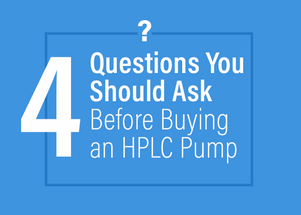29th Sep 2021
4 Questions You Should Ask Before Buying an HPLC Pump
Chrom Tech’s positive-displacement piston pumps are used for a wide variety of analytical, clinical, preparative, and fluid-metering applications. Many of our customers use our HPLC pumps for delivering solvents to a chemical reaction system or other engineering or pharmaceutical manufacturing applications rather than for HPLC.
How Do You Choose What Type of HPLC Pump Will Work Best for Your Application?
There are a number of factors to consider when deciding what type of HPLC pump will work best for a solvent delivery application. The video above is a quick “buyer’s guide” and below I’ll go into more details of what should be considered when choosing between the different types of HPLC pumps.
1. Consider the Application
When we are working with potential pump customers the first question we will often ask is “What is your application?”. This is a high-level question – we don’t need to know specifics. What we really want to know is the type of solvents you’ll be using. Most solvents can be accommodated by our pumps’ wetted materials, however it’s important to verify that solvents are compatible with the wetted materials of the flow path in the pump.
2. Do You Need Constant Flow or Pressure?
Sometimes, constant pressure is necessary for solvent delivery, such as for packing columns or adding an evenly pressurized solvent into a system. Chrom Tech offers a few different options for constant pressure pumps, although constant flow rate pumps are more common in our customer base. It will also be important to consider what flow rates and pressure limits you’ll be working with.
3. Are You Concerned with Pulsation?
Pulsation isn’t always a concern for our customers. When pulsation is not a concern, you can get away with less “bells and whistles” in your pump, which saves you money! However, when a constant flow is important and pulsation is a concern, we do have solutions for you. If you’re unfamiliar with how piston pumps work, the pulsation of a single piston pump comes from the piston filling and delivering solvent. So, to combat this, pulse dampeners can be added. Even though this is a huge improvement to the pulsation from a single piston pump without a pulse dampener, an even better solution in addition to the pulse dampener is to add a second piston (known as a dual piston pump). This allows for one piston to deliver solvent while the other piston is refilling the second pump head, thus drastically reducing pulsation.
4. Other Considerations Before Purchasing a Pump
One last factor to consider is the temperature of your solvents. Whether hot or cold, we have options. For extreme temperatures, or temperatures that need to stay consistent, we offer jacketed pump heads for our stainless steel flow path pumps. For more information or for assistance finding a good pump for your application, please reach out to our support team.

